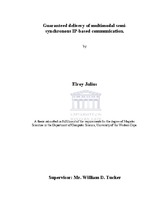| dc.contributor.advisor | Tucker, William | |
| dc.contributor.author | Julius, Elroy Peter | |
| dc.contributor.other | Dept. of Computer Science | |
| dc.contributor.other | Faculty of Science | |
| dc.date.accessioned | 2013-05-23T08:55:26Z | |
| dc.date.available | 2007/03/12 08:50 | |
| dc.date.available | 2007/07/27 | |
| dc.date.available | 2013-05-23T08:55:26Z | |
| dc.date.issued | 2005 | |
| dc.identifier.uri | http://hdl.handle.net/11394/197 | |
| dc.description | Magister Scientiae - MSc | en_US |
| dc.description.abstract | A semi-synchronous environment consists of a combination of synchronous and asynchronous transport media used to transport messages from source to destination. This thesis explores an empirical solution for guaranteeing the delivery of messages in a multimodal semi-synchronous environment for a Deaf Telephony application. SoftBridge for Instant Messaging Bridging Application (SIMBA), is a communication platform that make use of a semi-synchronous framework to allow a hearing and Deaf person to communicate inside a single uniform space. SIMBA was
modified to provide reliability for both synchronous and asynchronous transport media. In the process of modification, SIMBA was renamed to NaradaBrokering integrated in SIMBA (NIMBA). Within the literature various systems are analyzed and successes and failures are distilled to help formulate a good solution for the thesis question. To guarantee asynchronous messages sent, the Message Oriented Middleware (MOM) paradigm was used with Forward Error Correction (FEC) used to guarantee the delivery of synchronous messages sent. The work forms part of a
social study conducted at the Deaf Community of Cape Town (DCCT) community centre. Ethnography was used to identify the requirements for a Deaf Telephony application. Thus, this thesis is based on a socio- technical environment where the system is developed in a laboratory and tested in an actual community. Results show that these solutions are cceptable for a semi-synchronous communication environment. However, interviews conducted with a select group of Deaf participants showed that cell phones are currently too popular to be replaced by NIMBA as a primary communication device and service. This is due to the immense popularity of
Short Message Service (SMS) among the Deaf and cell phone devices mobile
capabilities. The overall goal of the thesis is to guarantee delivery for a semisynchronous environment with broader implications of showing how multimodal semi-synchronous services like Deaf Telephony can be made attractive to service providers concerned with reliability in the new Internet Protocol (IP) world of telecommunications. | en_US |
| dc.language.iso | en | en_US |
| dc.publisher | University of the Western Cape | en_US |
| dc.subject | Telecommunication systems | en_US |
| dc.subject | Instant messaging | en_US |
| dc.subject | Internet telephony | en_US |
| dc.title | Guaranteed delivery of multimodal semi-synchronous IP-based communication. | en_US |
| dc.type | Thesis | en_US |
| dc.rights.holder | University of the Western Cape | en_US |
| dc.description.country | South Africa | |

